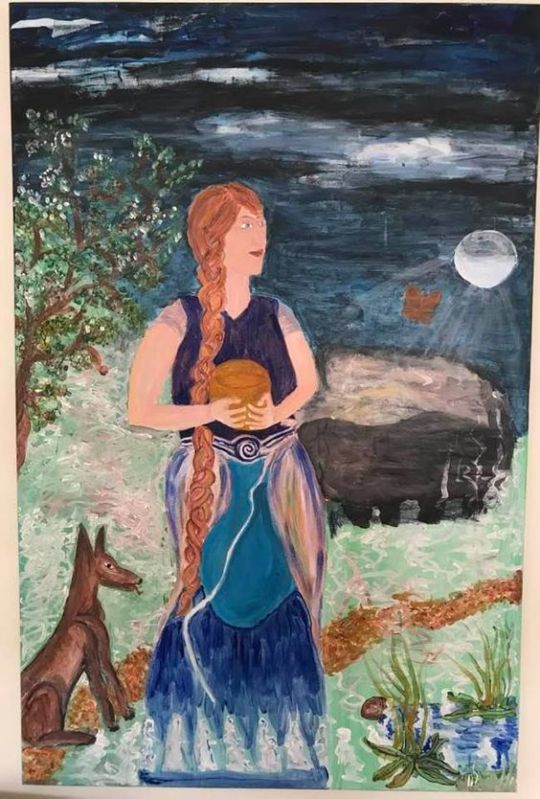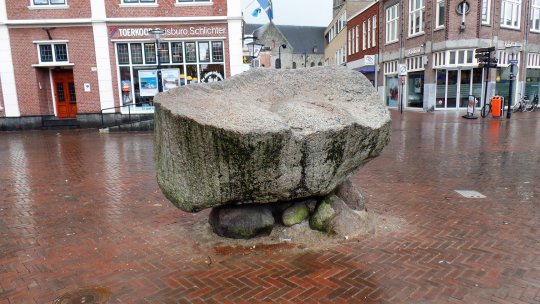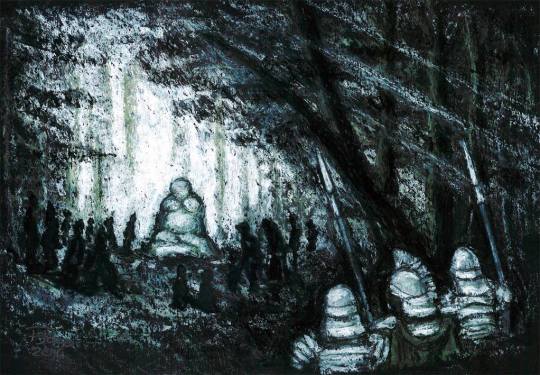#the tanfana stone
Text
Susurrus from Ophidian Forest
The only way I can think to describe this is if Mephistofeles made a black metal song. This goes so hard, the organ is the perfect addition to this and really sends it to perfection. Jam this shit
5 notes
·
View notes
Photo




Tanfana
Tanfana is a local Germanic Goddess who was worshipped in modern day Germany and the Netherlands. She has been mentioned by Tacitus in his work the annals. Besides Tacitus' mention and a few local legends, little is known about this Goddess. The meaning of her name still remains a debate, it could have been derived from the Proto-Germanic word Tafnano meaning 'Goddess of the sacrificial animal'.
Tacitus mentions a slaughter and the destruction of Tanfana's temple in the annals book 1 chapter 51:
"Cæsar, to spread devastation more widely, divided his eager legions into four columns, and ravaged a space of fifty miles with fire and sword. Neither sex nor age moved his compassion. Everything, sacred or profane, the temple too of Tanfana, as they called it, the special resort of all those tribes, was levelled to the ground. There was not a wound among our soldiers, who cut down a half-asleep, an unarmed, or a straggling foe. The Bructeri, Tubantes, and Usipetes, were roused by this slaughter, and they beset the forest passes through which the army had to return."
The location of this mentioned Tanfana temple is not 100% certain but theories suggest that this temple was perhaps located on the Tankenberg, the Netherlands. The mayor of Brinkhorst placed this quote of Tacitus on top of the Tankenberg in 1844 as a nod to the Goddess Tanfana. Other theories suggest that this temple must have been located somewhere between the rivers Ruhr and Lippe in modern day Germany.
But who is Tanfana exactly? Tacitus described that this slaughter took place 5 years after the historical defeat at the battle of Teutoburgerwald. It was general Germanicus, cousin of the emperor Tiberius, who attacked the Marsi tribe and committed this slaughter. Germanicus attacked the Marsi while they were preparing a big feast in honour of the Goddess Tanfana.
By looking at the date of the slaughter, on a full moon somewhere around the equinox in the year 14AD, possible around 24/25th September, we can guess that Tanfana might be a Goddess of fertility since September is a harvest month. The Marsi could have held this feast in order to thank Tanfana for the succesfull harvest. During this feast, animals were sacrificed on a big sacred stone, if the temple was indeed located on the Tankenburg, it could have been the sacred stone which is still visible these days on the market of Oldenzaal.
Unfortunately with the arrival of the Christians a few centuries later, Tanfana had to be erased from history. So she was, like many other deities and beings, demonized by the church. Tanfana was depicted as an evil old witch known in the Dutch child rhyme: Anneke, Tanneke, Toverheks. This rhyme is sung by children sitting in a circle, one of the children plays as the witch Tanneke while another plays as a dog who has to catch the witch. Tanfana, according to the church, would eat small children and sacrifice them to the devil himself.
Tanfana is certainly an interesting Goddess who had to suffer the wrath of the Romans after they lost several legions in the famous Teutoburgerwald battle in 9AD. A Goddess of fertility and harvest with similarities to Nerthus sadly demonized by the church.
Here are pictures of:
Modern day depiction of Tanfana by Anneke Wittermans,
Tankenberg with Tacitus' quote in the Netherlands,
The Tanfana stone now located in Oldenzaal,
Romans approaching Tanfana's temple art by Polly,
46 notes
·
View notes
Text
Susurrus from Ophidian Forest
0 notes
Photo









Here is a list of local Dutch Germanic Gods/Goddesses who are almost forgotten in history. The Netherlands is only a small country so imagine how many local Germanic Gods there are, mostly forgotten sadly. (sorry for my lack of activity the last few days, I caught a cold and I am not feeling too well, no it is not Corona haha)
-Nehalennia (Goddess of the sea and fertility)
-Baduhenna (Frisii Goddess of war)
-Hurstrga (unknown Batavi Goddess)
-Arcanua (possible Roman Goddess adopted by the Germanics)
-Burorina (Unknown Goddess, inscription of her name found in Domburg)
-Epona (Original Celtic Goddess adopted by the Germanics)
-Exomna (Batavi Goddess, name means 'without fear')
-Foste (God of justice similar to the Norse Forseti)
-Hercules Magusanus (Local variant on Donar/Thor)
-Warns (local variant of Wodan, Austrian village of Warnsdorf, Frisian village of Warns and the Dutch village of Warnsveld are perhaps named after him)
-Tanfana (possible local variant of Hel or Nerthus)
-Sandraudigr (Inscription of her name was found on an altar stone in Rijsbergen. Perhaps the cityies of Zundert and Zandrode are named after this Goddess)
-Rura (Probably the Goddess of the river Roer, altar stones found near Roermond)
-Nerthus (Mother earth, Goddess of fertility, Tacitus described a whole ritual surrounding her)
-Mopates (Unknown Goddess whose name was discovered on an altar near Nijmegen)
-Isecaeneuga (Unknown Batavi Goddess)
-Hludana (Earth Goddess, mother of Donar, altar stone to her was found in Frisia)
-Haeva (Batavi Goddess, inscription of her found near Wijk bij Duurstede, might be the wife of Donar)
-Rekwaliwa (Possible God of darkness, forests or death, might also be another name for Wodan but too little is known about him)
Here are photos of:
Altar stones of Nehalennia, Exomna, Hludana, Hercules Magusanus, Burorina.
Batavi Temple,
Depiction of Epona
Depiction of Baduhenna
Foste
63 notes
·
View notes
Photo

This is the offering stone of Tanfana here in the Netherlands. Tanfana is a Germanic Goddess of fertility and upon this very rock, offers were made to her.
There are many Dutch myths surrounding this stone and its original place, from kabouters to the witte wieven. If one of you guys ever visit the Netherlands or live here, go and visit Tankenberg in the Netherlands, it is a place of power to the Germanic people.
197 notes
·
View notes